Navigation/Menü: Links auf weitere Seiten dieser Website und Banner
21.04.2004
HRSC Bildserie #034 - Olympus Mons West (Orbit 0143)
HRSC Press Release #034 - Olympus Mons West (orbit 0143)
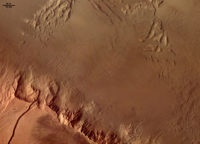 Die Bilddaten wurden am 24. Februar 2004 im Orbit 143
aus einer Höhe von 266 km von der hochauflösenden
Stereokamera HRSC auf Mars Express mit einer Auflösung von etwa
25 Meter pro Bildpunkt aufgenommen. Das Bildzentrum liegt bei
222° Ost und 22° Nord. Norden ist rechts.
Die Bilddaten wurden am 24. Februar 2004 im Orbit 143
aus einer Höhe von 266 km von der hochauflösenden
Stereokamera HRSC auf Mars Express mit einer Auflösung von etwa
25 Meter pro Bildpunkt aufgenommen. Das Bildzentrum liegt bei
222° Ost und 22° Nord. Norden ist rechts.
The images were taken by the high-resolution stereo camera (HRSC) on Mars Express in orbit 143 on 24 February 2004 from an altitude of 266 km. The images were taken with a resolution of about 25 metres per pixel and are centered at 222° East and 22° North. North direction is to the right.
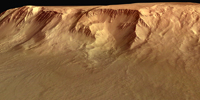 Die Aufnahmen zeigen einen Ausschnitt des Westabbruchs des
Tharsis-Vulkans Olympus Mons. Die maximale Höhendifferenz
zwischen der Vulkanflanke und der Ebene beträgt über 7000 m.
Das Gebiet westlich des Steilabbruchs ist gekennzeichnet durch
gravitative Massenbewegungen, die vom Steilabbruch in das Vorfeld
des Vulkans reichen. Im anstehenden Gestein an der Oberkante des
Steilabbruchs ist eine deutlich ausgebildete Schichtung zu
erkennen.
Die schmalen konzentrischen Rücken in der Ebene deuten auf
Materialtransport über eine Distanz von mehreren hundert
Kilometern hin. Eine glaziale Überprägung oder sogar ein
glazialer Ursprung wird nicht ausgeschlossen. Das transportierte
Material hat sich in der sog. Aureole um den Vulkanbau
gesammelt.
Die Aufnahmen zeigen einen Ausschnitt des Westabbruchs des
Tharsis-Vulkans Olympus Mons. Die maximale Höhendifferenz
zwischen der Vulkanflanke und der Ebene beträgt über 7000 m.
Das Gebiet westlich des Steilabbruchs ist gekennzeichnet durch
gravitative Massenbewegungen, die vom Steilabbruch in das Vorfeld
des Vulkans reichen. Im anstehenden Gestein an der Oberkante des
Steilabbruchs ist eine deutlich ausgebildete Schichtung zu
erkennen.
Die schmalen konzentrischen Rücken in der Ebene deuten auf
Materialtransport über eine Distanz von mehreren hundert
Kilometern hin. Eine glaziale Überprägung oder sogar ein
glazialer Ursprung wird nicht ausgeschlossen. Das transportierte
Material hat sich in der sog. Aureole um den Vulkanbau
gesammelt.
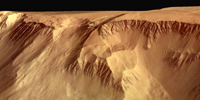 The images show the western flank of the Tharsis-volcano Olympus
Mons in the western Martian hemisphere. The elevation of the
escarpment reaches from about 0 m to over 7000 m. The extensive
plains west of the escarpment are characterized by ridges and
furrows which are connected to mass movements down the slope.
Large masses of shield material can be found in the circum
-Olympus aureole area. Several indications suggest a development
and resurfacing connected to glacial activity.
The images show the western flank of the Tharsis-volcano Olympus
Mons in the western Martian hemisphere. The elevation of the
escarpment reaches from about 0 m to over 7000 m. The extensive
plains west of the escarpment are characterized by ridges and
furrows which are connected to mass movements down the slope.
Large masses of shield material can be found in the circum
-Olympus aureole area. Several indications suggest a development
and resurfacing connected to glacial activity.
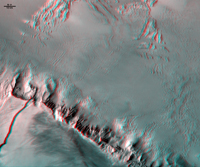 Die Farbansichten wurden aus dem senkrecht blickenden Nadirkanal und den Farbkanälen erstellt, die Schrägansicht wurde aus den Stereokanälen der HRSC berechnet. Die Anaglyphen werden aus dem Nadirkanal und einem Stereokanal abgeleitet. Die schwarzweißen Detailaufnahmen wurden dem Nadirkanal entnommen, der von allen Kanälen die höchste Auflösung zur Verfügung stellt.
Die Farbansichten wurden aus dem senkrecht blickenden Nadirkanal und den Farbkanälen erstellt, die Schrägansicht wurde aus den Stereokanälen der HRSC berechnet. Die Anaglyphen werden aus dem Nadirkanal und einem Stereokanal abgeleitet. Die schwarzweißen Detailaufnahmen wurden dem Nadirkanal entnommen, der von allen Kanälen die höchste Auflösung zur Verfügung stellt.
The colour scenes have been derived from the three HRSC-colour channels and the nadir channel. The perspective views have been calculated from the digital terrain model derived from the stereo channels. The anaglyph image was calculated from the nadir and one stereo channel. The black and white high resolution images were derived form the nadir channel which provides the highest detail of all channels.
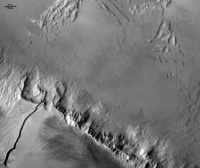 Das Kameraexperiment HRSC auf der Mission Mars Express der
Europäischen Weltraumorganisation ESA wird vom Principal Investigator Prof. Dr.
Gerhard Neukum (Freie Universität Berlin), der auch die technische Konzeption der
hochauflösenden Stereokamera entworfen hatte, geleitet. Das
Wissenschaftsteam besteht aus 40 Co-Investigatoren aus 33 Institutionen und zehn
Nationen. Die Kamera wurde am Deutschen Zentrum für Luft- und Raumfahrt (DLR) unter der
Leitung des Principal Investigators (PI) G. Neukum entwickelt und in Kooperation mit
industriellen Partnern gebaut (EADS Astrium, Lewicki Microelectronic GmbH und Jena
-Optronik GmbH). Sie wird vom DLR -Institut für Planetenforschung in Berlin-Adlershof
betrieben. Die systematische Prozessierung der Daten erfolgt am DLR. Die Darstellungen
wurden vom Institut für Geologische Wissenschaften der FU Berlin in Zusammenarbeit
mit dem DLR-Institut für Planetenforschung erstellt.
Das Kameraexperiment HRSC auf der Mission Mars Express der
Europäischen Weltraumorganisation ESA wird vom Principal Investigator Prof. Dr.
Gerhard Neukum (Freie Universität Berlin), der auch die technische Konzeption der
hochauflösenden Stereokamera entworfen hatte, geleitet. Das
Wissenschaftsteam besteht aus 40 Co-Investigatoren aus 33 Institutionen und zehn
Nationen. Die Kamera wurde am Deutschen Zentrum für Luft- und Raumfahrt (DLR) unter der
Leitung des Principal Investigators (PI) G. Neukum entwickelt und in Kooperation mit
industriellen Partnern gebaut (EADS Astrium, Lewicki Microelectronic GmbH und Jena
-Optronik GmbH). Sie wird vom DLR -Institut für Planetenforschung in Berlin-Adlershof
betrieben. Die systematische Prozessierung der Daten erfolgt am DLR. Die Darstellungen
wurden vom Institut für Geologische Wissenschaften der FU Berlin in Zusammenarbeit
mit dem DLR-Institut für Planetenforschung erstellt.
The High Resolution Stereo Camera (HRSC) experiment on the ESA Mars Express Mission is led by the Principal Investigator (PI) Prof. Dr. Gerhard Neukum who also designed the camera technically. The science team of the experiment consists of 40 Co-Investigators from 33 institutions and 10 nations. The camera was developed at the German Aerospace Center (DLR) under the leadership of the PI G. Neukum and built in cooperation with industrial partners (EADS Astrium, Lewicki Microelectronic GmbH and Jena-Optronik GmbH). The experiment on Mars Express is operated by the DLR Institute of Planetary Research, through ESA/ESOC. The systematic processing of the HRSC image data is carried out at DLR. The scenes shown here were created by the PI-group at the Institute for Geological Sciences of the Freie Universitaet Berlin in cooperation with the German Aerospace Center (DLR), Institute of Planetary Research, Berlin.
© Copyright: ESA/DLR/FU Berlin (G. Neukum)
Download
hochaufgelöste Bilddaten /
full resolution image data
Nadiraufnahme / Grayscale Nadir Image | download TIF (8.3 MB) |
RGB Farbbild / RGB Colour Image | download TIF (21.8 MB) |
Rot-Cyan Anaglyphe / Red-cyan anaglyphe | download TIF (27.8 MB) |
Perspektive #1 / Perspective view | download TIF (3.7 MB) |
Perspektive #2 / Perspective view #2 | download TIF (2.4 MB) |

 English
English

